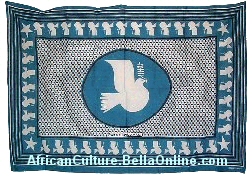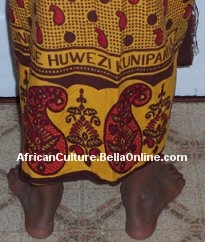What is a Khanga?

A khanga is a brightly colored piece of cloth that many East African women wear. Many wear khangas over their skirts while working in the fields to keep the dust of their skirts. Khangas are also worn as head wraps.


Other Swahili proverbs you may see on a khanga are:
"Embe mbivu yaliwa kwa uvumilivu" which means "A ripe mango has to be eaten slowly".
"Riziki Ya Mtu Hupangwa Na Mungu" which means "One's fortunes are planned by God".
"Haba na haba, hujaza kibaba" which means "Little and little, fills the measure".
A khanga is roughly 5 feet by 3 feet which makes it perfect for wrapping it around one's self. Generally, there is a border pattern around all four sides of the khanga with a central design in the middle. There is always a proverb - usually in Swahili - at the bottom of a khanga.
The word khanga is Kiswahili for guinea fowl. This came to be because khangas were originally several brightly colored Portuguese handkerchiefs, intended for gentlemen, sewn together to make a piece of cloth large enough to be worn around the body. These cloths were called khangas because the bright colors reminded people of guinea fowl. Later on, when the khanga began to be produced, some had a guinea fowl motif which reinforced the name khanga. The khanga cloth is a very lightweight loose weave fabric.
Khangas have been around for 80-plus years now. However, they are starting to fall out of favor as younger women prefer to dress in a more westernized style when they go out on the town.
Similar cloths are worn much the same way throughout Africa.


Other Swahili proverbs you may see on a khanga are:
"Embe mbivu yaliwa kwa uvumilivu" which means "A ripe mango has to be eaten slowly".
"Riziki Ya Mtu Hupangwa Na Mungu" which means "One's fortunes are planned by God".
"Haba na haba, hujaza kibaba" which means "Little and little, fills the measure".
A khanga is roughly 5 feet by 3 feet which makes it perfect for wrapping it around one's self. Generally, there is a border pattern around all four sides of the khanga with a central design in the middle. There is always a proverb - usually in Swahili - at the bottom of a khanga.
The word khanga is Kiswahili for guinea fowl. This came to be because khangas were originally several brightly colored Portuguese handkerchiefs, intended for gentlemen, sewn together to make a piece of cloth large enough to be worn around the body. These cloths were called khangas because the bright colors reminded people of guinea fowl. Later on, when the khanga began to be produced, some had a guinea fowl motif which reinforced the name khanga. The khanga cloth is a very lightweight loose weave fabric.
Khangas have been around for 80-plus years now. However, they are starting to fall out of favor as younger women prefer to dress in a more westernized style when they go out on the town.
Similar cloths are worn much the same way throughout Africa.
This site needs an editor - click to learn more!
You Should Also Read:
Forum Discussion - Wearing a Khanga
Kangas 101 Uses - Book Review
What is Shea Butter? 
Related Articles
Editor's Picks Articles
Top Ten Articles
Previous Features
Site Map
Content copyright © 2023 by Jeanne Egbosiuba Ukwendu. All rights reserved.
This content was written by Jeanne Egbosiuba Ukwendu. If you wish to use this content in any manner, you need written permission. Contact
BellaOnline Administration
for details.


